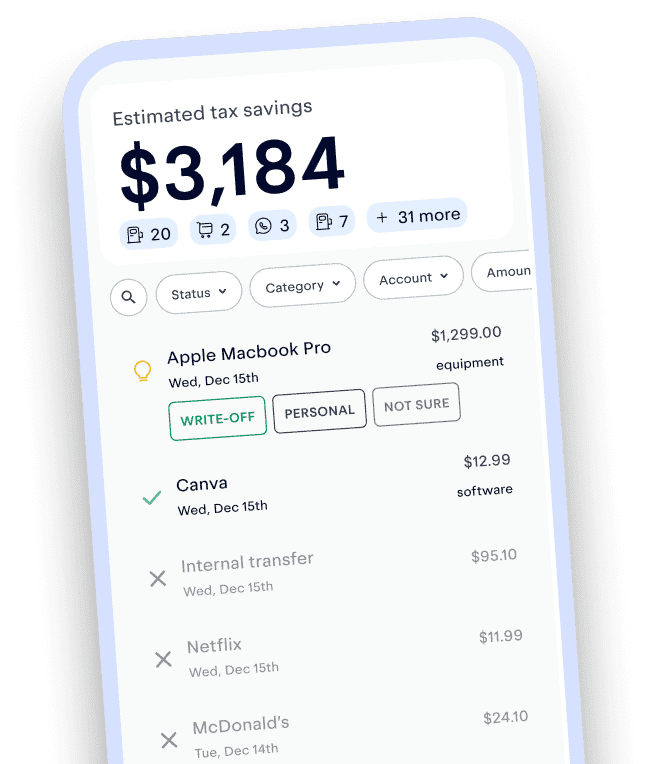

How to Pay Yourself with an S-Corp (Step-By-Step Guide)
Step 1: Determine a Reasonable Salary
This is the part the IRS cares about most.
If you're doing work for your business, you're legally required to pay yourself a “reasonable salary.” That means:
- You treat yourself like an employee
- You run payroll and withhold payroll taxes
So what’s considered “reasonable”?
It’s generally what someone else would earn doing your job full-time, based on your role, experience, industry, and location. We cover this in more detail further down this article. Since the IRS closely scrutinizes this, it's smart to talk to a tax pro. Keeper’s team can help you choose a salary that holds up to IRS standards.
Step 2: Set Up Payroll
Once you've determined a fair salary, the next step is to start payroll.
Use a payroll service like Gusto to:
- Send yourself regular paychecks
- Withhold and pay Social Security, Medicare, and income taxes
- File required forms and deposits
- Monthly payroll tax deposits
- Form 941 (Quarterly)
- Form 940 and W-2s (Annually(
A good payroll provider handles all the calculations and filings for you.
Step 3: Take Distributions from the Business
Once you've paid yourself a fair salary and covered your business expenses, you can take additional money out of the S-Corp. These are called “distributions.”
This is where the tax savings kick in.
Distributions aren’t subject to Social Security or Medicare taxes. They’re still taxed as income, but they’re not subject to the payroll taxes that your typical wages are. And you can transfer these funds straight from your business account to your personal account.
Just make sure you’re keeping clean records so your CPA (or Keeper 😉) can report everything correctly.
Caution: Be mindful that taking distributions in excess of your stock basis can lead to taxable income and potential penalties. Always track your basis carefully and consult your CPA before taking distributions beyond your investment in the company.
Example: Let’s Break It Down
Let’s say your S-Corp made $100,000 in profit this year.
You might:
- Pay yourself $50,000 in salary via payroll
- Take the remaining $50,000 as a distribution
That $50K gets taxed like a regular W-2 paycheck.
But the $50K? You skip the 15.3% self-employment tax — saving you over $7,000 in taxes.

Caution: Don’t mix business and personal expenses!
As an S-Corp, you need to be much more careful with how you handle funds. You need to have a separate business bank account for the S-Corp that doesn't mix personal expenses. This is really important for a few reasons. If you mix personal expenses with your business bank account:
- Those expenses can’t be deducted. So unless you’re tracking them very carefully, you could accidentally report it as a deduction at tax time and in the case of an audit, you’ll face penalties.
- The IRS might reclassify those purchases as taxable distributions or a disguised salary. Long story short – more penalties and back taxes.
- It can pierce the corporate veil. This means that if you’re sued, someone could argue that you and the business aren’t really separate entities, and you lose the limited liability protection that comes with your S-Corp/LLC.
How do you determine what a reasonable salary is?
The IRS tends to heavily scrutinize an S-Corporation’s “reasonable salary” decisions, so it’s important to get them right to avoid an audit.
Let’s look at what the IRS actually says about “reasonable compensation” (source)
- "S corporations must pay reasonable compensation to a shareholder-employee in return for services that the employee provides to the corporation before non-wage distributions may be made to the shareholder-employee. The amount of reasonable compensation will never exceed the amount received by the shareholder either directly or indirectly."
- "The instructions to the Form 1120-S, U.S. Income Tax Return for an S Corporation, state "Distributions and other payments by an S corporation to a corporate officer must be treated as wages to the extent the amounts are reasonable compensation for services rendered to the corporation."
- "The IRS has the authority to reclassify payments made to shareholders from non-wage distributions (which are not subject to employment taxes) to wages (which are subject to employment taxes). Several court cases support the authority of the IRS to reclassify other forms of payments to a shareholder-employee as a wage expense which are subject to employment taxes."
- “Some factors in determining reasonable compensation:
- Training and experience
- Duties and responsibilities
- Time and effort devoted to the business
- Dividend history
- Payments to non-shareholder employees
- Timing and manner of paying bonuses to key people
- What comparable businesses pay for similar services
- Compensation agreements
- The use of a formula to determine compensation”
Now let’s break down what this actually means:
If you run an S-Corp and work in the business, the IRS expects you to pay yourself a “reasonable salary” before taking any extra profits out of the company. In other words, you can’t just skip the paycheck and take all your income as distributions to avoid payroll taxes. The IRS wants to see you getting paid a fair wage for the work you do—just like any other employee.
If the IRS thinks you’re underpaying yourself and taking most of your income through distributions, they can step in and reclassify those distributions as wages, and hit you with back taxes and penalties.
So, what counts as a “reasonable” salary? The IRS looks at a bunch of things to decide: your experience, what kind of work you’re doing, how much time you’re spending in the business, how much money the company makes, what other people in similar jobs earn, and whether you’ve got any formal agreements or formulas in place to set your salary. The goal is to make sure your pay matches the value of the work you’re actually doing.
Bottom line: make sure you’re paying yourself a fair salary. It’ll help you stay IRS compliant and avoid any nasty surprises down the road.
Where can you look for data about salaries in your area?
The best way to break this down is to look at an example. So here’s the scenario:
Let’s say you own and operate a self-serve dog wash or grooming business in Seattle, Washington. You work 40 hours a week, have no other employees, and handle everything yourself—greeting customers, cleaning stations, handling scheduling and payments, managing supplies, and possibly doing some grooming or bathing too. Your business brings in $150,000 in net income per year, and you’ve been running it for about a year.
To figure out a reasonable salary, we need to ask: What would someone doing this job earn if they were hired as an employee?
Go to google and search for salaries for whatever the closest job title you can find is. In this example you might search “dog groomer” salaries. You’d find a Ziprecruiter article which reports the following data about dog groomer salaries in Seattle. Take a screenshot and save it somewhere you’ll remember. That’s one data point. You’ll want to gather a couple more.

On Indeed you can find this information:

Ziprecruiter and Indeed are great - but you want this salary to be bulletproof, so you go to the Bureau of Labor Statistics and find this data.

Now you have 3 complementary sources that show similar ranges for the work that you do. The average for these sources is somewhere around $53,000 with the upper bound at about $80,000. Since your job requires more than just animal care and grooming (you’re doing customer service, marketing, etc…) you can safely put yourself above the median, closer towards the upper bound.
Here’s what you should do next:
- Set your salary between $60,000–$80,000 annually.
- Document your choice using the local salary data you found and write down the details of your duties and hours.
- Run payroll on that amount.
- Take any remaining profits (after salary and expenses) as non-wage distributions.
- Reevaluate annually, especially if revenue or your role changes, and confirm with your CPA (or Keeper 🙂) to remain compliant.
Need help choosing a salary that won’t trigger IRS scrutiny? Book a free call with a Keeper tax expert and we’ll walk you through it!
What happens if don't pay yourself a reasonable salary
If you're taking distributions without a reasonable salary, the IRS may audit your return and reclassify those distributions as wages. That means:
- You’ll owe back payroll taxes (Social Security + Medicare) on all those payments
- Plus penalties and interest for underpayment
- Possibly additional accuracy-related penalties
Is the 60/40 rule legit for S-Corp salaries?
The 60/40 rule is a general guideline that you can split your income 60% to salary and 40% to distribution. While the 60/40 rule is an easy guideline to use, it’s not an approved method by the IRS and should not be followed blindly. To determine the right split, it’s best to consult a tax expert.
How often should you pay yourself (and take distributions) in an S-Corp?
Fortunately, the IRS doesn’t set any rules about how often you pay yourself in an S-Corp. You can pay yourself daily, weekly, once a year, or any cadence in-between.
Same with distributions - there’s no rules on how often you can take distributions, just that you pay yourself before any distributions are taken.
What if your S-Corp has multiple owners?
If your S-Corp has more than one shareholder — whether it’s a spouse, business partner, or co-founder — here’s how compensation and profit-sharing work differently:
Each working owner must be paid a salary
If two or more shareholders are actively working in the business, each one must be paid a “reasonable salary” as an employee. This is non-negotiable.
The IRS says that if you're a working owner, you can't just take distributions and avoid payroll taxes. Your salary needs to reflect what you actually do; owners can't get paid equally if only one person is doing all the work.
Couples be careful: Spouses often assume they can split income 50/50 even if only one is actively working. Nope — only active participants should be paid W-2 wages.
Distributions must be split according to ownership percentage
Distributions must be split according to ownership percentage. S-Corp distributions must be allocated based on each shareholder’s ownership stake — not based on who worked more, who brought in more clients, or who “deserves more.”
Let’s say you and your business partner split the business 60/40, respectively. And at the end of the year, once salaries and expenses are paid, you have $100,000 left in profits.
You’ll take $60,000 and they’ll take $40,000 in distributions (even if you worked full-time and they only worked part-time).
This is what your operating agreement dictates. You can’t decide to split profits differently unless you legally change the ownership percentages in your corporate documents.
You’ll each get a K-1 at the end of the year
Each shareholder will receive a Schedule K-1, which reports:
- Their share of the company’s profits (based on % ownership)
- Any distributions they received
- Other tax items (like deductions or credits passed through)
Even if one person reinvests their share instead of withdrawing it, they’re still taxed on their full share of the profit.
Pro tip: You can just upload your K-1 into Keeper at tax time and we’ll fill out your tax return with all the necessary information!
Make sure to have good bookkeeping and documentation
With a multi-owner S-Corp, proper documentation is key. Make sure that you have the following docs:
- A clear operating agreement or shareholder agreement that outlines who owns what and what the expectations are
- A separate payroll profile for each owner-employee
- A tax service (like Keeper) or payroll provider that understands how to handle multi-owner S Corps
But what if one owner doesn't work in the business?
Then you don’t have to put them on payroll — they’re just a passive owner.
They still get their share of distributions, and they’ll still receive a K-1, but they won’t get a W-2. Just be careful about how you document and communicate roles to avoid triggering IRS scrutiny.

Start your S-Corp with Keeper
Keeper tax experts can help through your S-Corp journey! Turn your LLC into an S-Corp, track all of your business deductions, and file personal and business taxes right from Keeper!

Sign up for Tax University
Get the tax info they should have taught us in school

Expense tracking has never been easier
Keeper is the top-rated all-in-one business expense tracker, tax filing service and personal accountant.
Get started
What tax write-offs can I claim?













